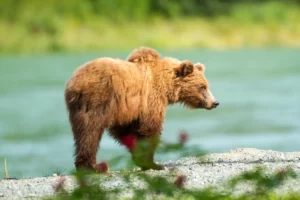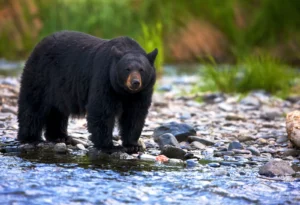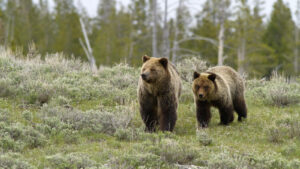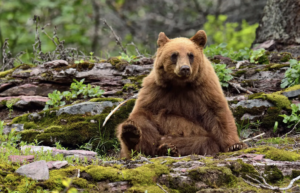This time of year, the greater Yellowstone ecosystem is one of the best places in the world to view bears in their natural habitat. But it can be difficult to determine what kind of bear you’re looking at! Black bears and grizzly bears are both species of bears found in Grand Teton, Yellowstone, and other parts of North America. While they share some similarities, there are several key differences between them.
Here are some of the main distinctions between grizzlies and black bears:

1. Size: Grizzly bears are significantly larger than black bears. Adult male grizzlies can weigh between 400 and 1,000 pounds (180-450 kg) and stand about 7 feet (2.1 meters) tall when on their hind legs. Adult male black bears, on the other hand, generally weigh between 150 and 600 pounds (68-270 kg) and stand about 6 feet (1.8 meters) tall.
2. Physical Appearance: Black bears have a sleek and slender build with a small head and rounded ears. They have shorter claws compared to grizzlies. Their fur can range in color from black to brown, cinnamon, or even blond. Grizzly bears have a larger and more muscular body with a pronounced shoulder hump. They have a concave facial profile, long claws, and prominent shoulder muscles. Grizzly bears have a distinctive grizzled appearance, with fur that varies in color from light brown to dark brown, often with white-tipped guard hairs.
 3. Range: Black bears have a wider distribution and can be found in various habitats across North America, including forests, swamps, and mountains. They are also found in parts of Mexico. Grizzly bears, also known as brown bears, are primarily found in the western and northwestern parts of North America, including Alaska, western Canada, and parts of the United States, such as Montana, Wyoming, and Idaho.
3. Range: Black bears have a wider distribution and can be found in various habitats across North America, including forests, swamps, and mountains. They are also found in parts of Mexico. Grizzly bears, also known as brown bears, are primarily found in the western and northwestern parts of North America, including Alaska, western Canada, and parts of the United States, such as Montana, Wyoming, and Idaho.
4. Behavior: Black bears are generally more adaptable and less aggressive than grizzly bears. They are excellent climbers and often retreat to trees when threatened. Black bears are primarily omnivorous, feeding on a wide range of food, including berries, nuts, insects, small mammals, and carrion. Grizzly bears are more powerful and tend to have a more aggressive disposition. They are primarily omnivorous but have a more carnivorous diet than black bears. Grizzlies are known to hunt larger mammals, such as elk and moose, and they are more likely to scavenge for carrion.

5. Hibernation: Both black bears and grizzly bears undergo a period of hibernation during the winter months, but there are some differences in their hibernation patterns. Black bears tend to have a shorter hibernation period, typically lasting around 3-5 months. Grizzly bears, especially those in colder regions, may have a longer hibernation period of up to 6-8 months.
6. Conservation Status: Black bears have a more stable population and are listed as least concern by the International Union for Conservation of Nature (IUCN). However, some localized populations of black bears, such as the Louisiana black bear, are listed as threatened. Grizzly bears, on the other hand, have a more vulnerable conservation status. They are listed as threatened or endangered in several regions due to habitat loss, hunting, and human-wildlife conflicts.
It’s important to note that these are general differences and there can be variations within each species.


